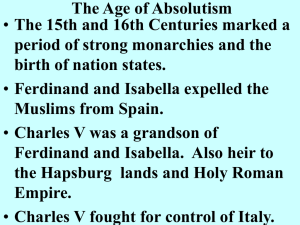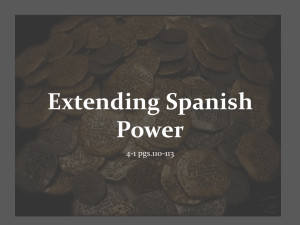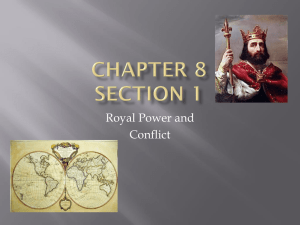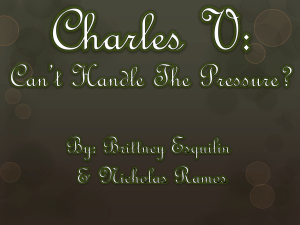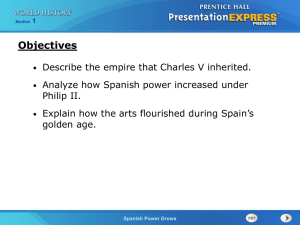The Monarchs of Europe
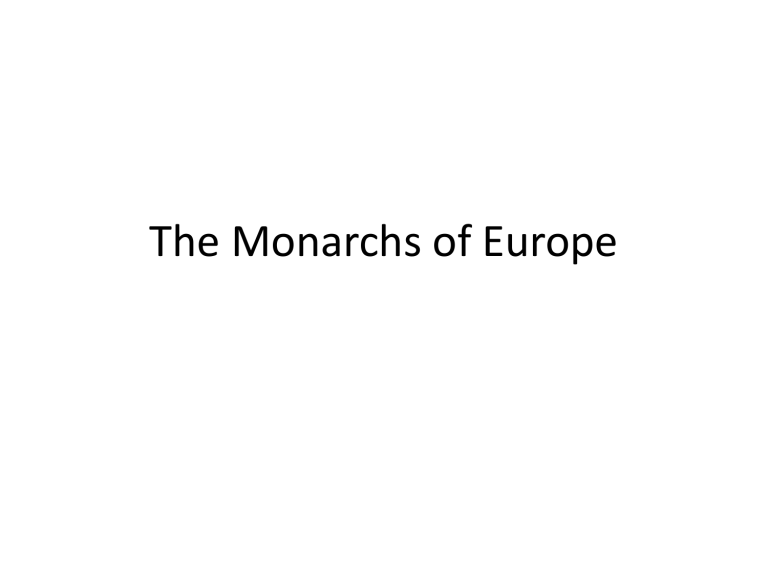
The Monarchs of Europe
Chapter 4, Section 1:
The Power of Spain
• Objective: Discuss and analyze the golden age and decline of Spain as a power.
• Key Terms and People: absolute monarch, divine right, Charles V, Peace of Augsburg, Philip II, El
Greco, Diego Velázquez, Miguel de Cervantes,
Sister Juana Ines de la Cruz, Spanish Armada
• Reading Focus: What challenges did King Charles I face when he became Emperor Charles V? What were some artistic achievements of Spain’s golden age? How did Spain rise and then decline under Philip II?
The King Becomes Emperor
• The Hapsburg family were powerful members of nobility throughout Europe. Every major power in
Western Europe were ruled by Hapsburgs.
• At the age of 16 Charles became King Charles I of
Spain. Charles, a part of the Hapsburg family, prepared to rule as an absolute monarch—a ruler whose power was not limited by having to consult with the nobles, common people, or their representatives.
• Absolute monarchs generally believed they ruled by divine right. This concept held that the monarchs received their power from God and therefore must not be challenged.
Absolute Monarch
Divine right
Charles V and the Empire
• When Charles became king of Spain, he inherited Belgium, the Netherlands, and colonies in the Americas.
• In 1519 Charles borrowed money to buy the votes to become Holy Roman Emperor as Charles V. His holdings expanded to parts of Italy, Austria, and various German states.
• On all sides Ottoman Turks, the French, and rebellious
German princes fought him.
• Charles was also fighting for religious control over Europe.
Charles wanted Europe to be Roman Catholic, and the
Protestant Reformation threatened his influence.
• In 1521 Charles declared Martin Luther an outlaw. In spite of Charles’s efforts, Protestants gained influence, and rebellions against Catholic rulers spread.
Charles V
Charles V and the Empire
• After years of devastating wars between Catholics and
Protestants, Charles V had to sign the Peace of
Augsburg. The agreement gave each German prince the right to decide whether his state would be Catholic or Protestant.
• Charles’s vision of a Catholic Europe never became reality, and constant warfare had brought him to the brink of bankruptcy.
• Charles V achieved more success in the Americas than he did in Europe. During his reign, Spanish explorers claimed much of the Americas for Spain with Cortes,
Pizarro, and Coronado as conquistadors, silver and gold began to flow from the American colonies, bringing
Spain wealth.
Peace of Augsburg
Dividing the Empire
• Charles V gave up his thrones in 1556, frustrated by his failures in Europe, dividing his large empire between his brother and his son.
• His brother took over the old Hapsburg holdings in Austria. His son, Philip II, ruled the
Netherlands, Spain, Sicily, and Spain’s colonies in the Americas.
• Charles V lived the rest of his life in a Spanish monastery, his dream of a unified empire unfulfilled.
Phillip II
Artistic Achievements
• From about 1550to 1650 Spain had a golden age, known as the Golden Century, of artistic achievement.
One of the most prominent painters was a Greek, known as El Greco. Much of his work was religious and reflected Spain’s central role in the Counter-
Reformation. El Greco’s style is famous for elongated human figures.
• Another Spanish painter, Diego Velázquez, created masterpieces that portray people of all social classes with great dignity. Velazquez had the privilege of being the court painter.
El Greco
Diego Velazquez
Artistic Achievements
• The Spanish golden age also produced writers, the greatest being Miguel de Cervantes. His most famous work, Don Quixote de la
Mancha, is about a man who is caught between the medieval and modern worlds.
• Another writer, a Mexican nun named Sister
Juana Ines de la Cruz, wrote poetry, prose, and plays. Church officials criticized Sister
Juana for her belief that women had a right to education.
Miguel de Cervantes
Sister Juana Ines de la Cruz
Spain Under Phillip II
• Spain its golden age during the reign of Philip
II. One reason for this prosperity was the steady stream of gold and silver that flowed from its
American colonies. With this immense wealth,
Spain’s power grew considerably. Eventually, though, American gold could not solve Spain’s problems.
Religion and Revolt
• King Philip II, also a devout Catholic , saw himself as a leader of the Counter-Reformation. Philip married Queen
Mary I of England, a Catholic. She died before she could give birth to an heir.
• Philip also wanted to secure Catholicism in his European territories but the Calvinist Protestantism was spreading through the Netherlands, Belgium, and Luxembourg.
• A bloody revolt began in the 1560s when the Dutch refused to declare allegiance to Philip. To punish them, he set up a court, known locally as the Court of Blood, that tortured and executed thousands of people suspected of being rebels. This only made the situation worse, and a new rebellion broke out, and dragged on for decades. In 1609, a truce was reached. The seven northern provinces formed the independent nation of the Netherlands, while the southern provinces remained in Spanish hands.
Spain and England
• The English sent aid to the Dutch rebels, infuriating
Philip.
• In addition, England’s Queen Elizabeth I was allowing her ship captains to attack Spanish treasure ships coming from America, who’s captains stole the gold and silver for England.
• Philip ordered his navy to assemble a great fleet, the
Spanish Armada. It totaled about 130 ships and 20,000 soldiers and sailors. The fleet, which was called invincible, sailed into the English Channel in 1588.
• The English set eight ships on fire and aimed them at the remaining ships of the Armada. In panic and disarray, the Spanish ships fled before the English fire ships. The Armada was defeated.
Spanish Armada
An Empire in Decline
• Spain recovered from the loss of the Armada, but
England remained Protestant and undefeated.
• Spain’s problems were internal. Philip’s insisted on approving every decision himself, and government action practically came to a standstill. Philip also spent the wealth from the Americas on constant warfare and went bankrupt four times.
• The flood of American gold and silver drove up prices, leading to inflation. Meanwhile, Spain did not develop industries, relying instead on its traditional agricultural economy. As a result, Spain lagged behind that of other countries, and gradually declined as a major power.
Wrap Up
• What challenges did King Charles I face when he became Emperor Charles V?
• What were some artistic achievements of
Spain’s golden age?
• How did Spain rise and then decline under
Philip II?

